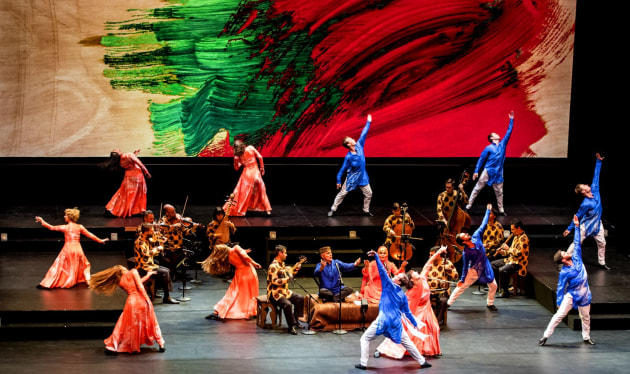Review: Layla and Majnun
Mark Morris Dance Group and Silkroad Ensemble
State Theatre, Melbourne
October 11
This year’s Melbourne International Arts Festival does not have a large focus on dance, with only three dance works and a circus featured. However, the dance is diverse. Layla and Majnun is an opera with dance and in this way is an opportunity for audiences to experience music, song and dance in a very concentrated form. Even more interesting, the opera, with its references to ancient musical traditions, is far away from the Western canon. The first piece of composed music made in Azerbaijan, this version was written in 1908 and takes its story from a 16th century rendition of a thousand-year-old tale of doomed love. The opera is a distillation from a three-hour work and tells its story in five short acts or episodes. Two iconic ensembles - Californian-based Mark Morris Dance Group and the Silkroad Ensemble joined forces in 2016 to bring this Azerbaijan work to fruition in its current form.
There are the three very distinct threads working in Layla and Majnun, with the story and music at its heart. Mugham singing is featured throughout and is a very particular art involving skilful improvisation. The singers, Alim Qasimov and Fargana Qasimova are world renowned exponents of this style. Silkroad Ensemble was founded by the legendary cellist Yo-Yo Ma and features a very eclectic mixture of Western and non-Western instruments. In Layla and Majnun, the result is a very different way of making and hearing music: quite dramatic, nuanced and almost declamatory in its story-telling.
The music is not only at the emotional heart of Layla and Majnun but it is physically positioned centre-stage. Dancers weave a loose interpretation of the tale on a series of raised steps around the musicians and singers. The choreography incorporates repetition and gesturing, grouping and partnering. Paired arabesques, whirling and rapid bourré-type motifs create an impressionistic wash to accompany the music and song. Pairs of dancers take turns in representing the lovers in different sections of the work, giving the story a symbolic and universal feel.
As a design feature, the dance works quite well - it has a painterly quality, resembling a Persian tapestry, with its sprinkling of colourful and identically dressed multiples of Laylas and Majnuns in coral flowing gowns and blue tunics respectively. However, the choreography lacks dimension and sometimes feels decorative. Specifically, choreographic ideas often draw on a stylised imagining of eastern European and west Asian dance styles that feel rather flippant and stereotypical. It seems like a wasted opportunity not to use some deeper elements of culture-appropriate traditional dance rather than simply gesturing toward such dance lineages.
The State Theatre was under-attended on the night I saw Layla and Majnun. Perhaps the production needed the infrastructure of a major theatre and the stage size of the State Theatre to accommodate all performers but such a big space felt remote and distancing rather than inviting and absorbing. To add to the sense of forlornness, the theatre seemed to be largely closed, as if it had given up on the work. A more intimate space might have created a warmer and more involving experience.
Mark Morris was reportedly reluctant to undertake the choreography for this work but was pressed by Yo-Yo Ma and eventually entered the collaboration. Unfortunately the choreographic contribution of Layla and Majnun does feel like a bit of an afterthought or an add-on.
- SUSAN BENDALL
Photo: SUSANA MILLMAN



